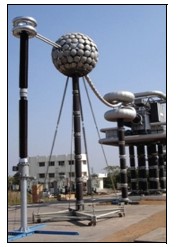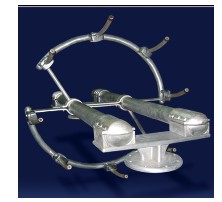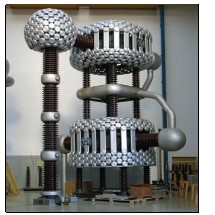
In the coming years, India is expected to set a
world precedent - transmitting electricity at ultra
high levels of 1,200kV. Power Grid Corporation of
India, the Central transmission utility, is
spearheading the project with the support of
indigenous equipment manufacturers and service
providers.
Venugopal Pillai attempts to give
an overview of recent developments in this
special report.
Power Grid Corporation of India Ltd,
the Central transmission utility, is
building a test station at Bina in
Madhya Pradesh, to set up a pilot project
to transmit power at 1,200kV levels. The
1-km test line is expected to be completed
by 2012. The results will determine the
feasibility and deployment of this ultra
high voltage technology—currently the
highest voltage at which power is
transmitted anywhere in the world.
Need for UHVAC: India today has
installed power capacity of around 1.7
lakh mw, which is expected to grow by
around 7 per cent annually. By 2027,
India's peak power demand would be 5
lakh mw, necessitating an installed
power capacity of at least 7 lakh mw.
Growth in generation capacity needs to
be matched by efficient power transmission and UHVAC technology is
one means to this end.
Power transmission in India is fraught
with inherent difficulties. First, power
transmission is a land-centric activity. The
geographical footprint of a power
transmission system is far more expansive
than that of a power generation plant.
Securing right of way for a power
transmission project is perhaps the
biggest hurdle in constructing a power
transmission line. The land-related
challenges of a power transmission line
are both topographical (physical) and
emotional. Securing right of way for
transmission lines that pass through
forests or private land is a perennial
challenge. The rationale behind going in
for ultra-high voltage transfer is simple—
when right of way for a transmission line is
in place, exploit it to the fullest.
The second reason why India will need a
sprawling and robust power transmission
network is the fact that power generation
centres are very different from
consumption centres. The eastern and
north-eastern regions are centres for
power generation with highly
incommensurate power consumption
levels. In the case of the northern, western
and southern regions, there is more
consumption that local generation. This
warrants the need for bulk transfer of
power between far-flung regions.
Secondly, India is also planning to import
power from hydro-rich neighbours like
Nepal, Bhutan and Bangladesh. This also
creates the need for high-voltage crossborder
lines, dovetailing with India's
national grid.

The efficiencies obtained by high
voltage power transmission lines are very
striking. A 400kV line can typically carry
400 mw of power. When one moves to
800kV, power transfer between 1,200-
2,400 mw is possible. A 1,200kV UHVAC
line can transfer 6,000-8,000 mw of
power. On the other hand, though, there
are engineering challenges as one moves
to higher voltages. Power transmission at
lower voltages (220kV or even 400kV) is much more manageable that than say
765kV or 800kV.
Industry experts say that building a
1,200kV power transmission line is not
the main challenge. All the equipment—
towers, conductors, transformers,
breakers, insulators, hardware, etc—can
be produced domestically. There is no
dearth of expertise. The main challenge is
the ability to continuously and
consistently keep live a fully-charged
1,200kV line. The performance of a fully charged
1,200kV line will be known only
with time, and this is precisely what is
going to be achieved by the Bina test
station of PGCIL. The test line will
monitor the performance of the
associated equipment over prolonged
"live" conditions. An industry expert felt
that even if India installs 1,200kV power
transmission infrastructure, it will take
some more time before the country is
equipped with fully-charged transmission
lines pressed into continuous operations.
Global scenario: China has been an
active proponent of UHVAC technology.
In January 2009, it set up three
1,100kV power transmission stations
that have been in continuous operation
although it is not known whether the
lines were charged at the highest level.
China has more such lines in the
planning stage. China is a vast country
and the need for bulk transfer of power
over long distances is as acute as
India's. Japan built a 1,000kV test
station way back in 1993 in what is
perhaps the world's pioneering effort in
UHVAC technology. USA and Brazil
are also exploring possibilities of
setting up ultra high voltage power
transmission infrastructure.
A novel PPP approach: India's
1,200kV aspirations represent a unique
form of public private partnership. While
Power Grid Corporation of India is at the
helm of affairs, the endeavour is
supported by around 35 domestic
manufacturers and service providers. The
following is a brief description of some
companies and their achievements in this
path-breaking national ambition.
Bharat Heavy Electricals: This Central
PSU engineering major is actively
involved in the 1,200kV pursuit by
providing key equipment. In July this year,
BHEL announced that it developed its
first indigenous 1,200kV transformer of
333MVA rating that will be used at the
Bina test station. BHEL is also involved in
the supply of other key equipment
including 1,200kV insulators.
Crompton Greaves: Thapar Group
company Crompton Greaves in December
last year dispatched a 1,200kV capacitive
voltage transformer for the Bina test
station. The product developed with
indigenous technology at CG's Nashik
plant in Maharashtra was tested at
Central Planning & Research Institute
(CPRI), Hyderabad. CG has promised to
deliver some more equipment including a
333MVA power transformer of 1,200kV
rating and a 1,200kV surge arrestor.
 Larsen & Toubro
Larsen & Toubro: In late 2009, Larsen
& Toubro established India's largest
transmission line research centre at
Kancheepuram in Tamil Nadu. The centre
is equipped to test transmission towers of
up to 95m height required for 1,200kV
power transmission lines. This testing
station, according to L&T, enables to
design and validate innovative
configurations without any limitations on
size, shape and magnitude of loading,
which is currently not possible in the
industry due to restriction of available
testing facilities.
Vijai Electricals: This Hyderabadbased
company recently delivered a
333MVA single-phase 1,200kV power
transformer to PGCIL for use at the Bina
test station. The mammoth transformer
was built by Vijai Electricals using inhouse
technology at its Rudraram works
in Hyderabad, Andhra Pradesh.
Areva T&D India: The power
transmission business of Areva T&D India
recently flagged a 1,200kV capacitive
voltage transformer from its Hosur plant
in Tamil Nadu, for deployment at the Bina
test station. Areva T&D India, now part of
Alstom Grid, will further support the
1,200kV endeavour with disconnectors
and digital current transformers.
KEC International: RPG Group company
KEC International has been awarded the
contract to construct the 1,200kV test line
at Bina. KEC has established a tower
testing station at Butibori in Nagpur. Two
towers have already been type-tested and
have been deployed at the 400kV Nagpur-
Wardha transmission line will be eventually
upgraded to 1,200kV levels.
Supreme & Co: Kolkata-based
Supreme & Co has been selected for the
supply of several hardware fittings &
accessories like clamps, connectors,
corona control rings, etc. The company
displayed its 1,200kV product range at
the Gridtech 2011 event held in New Delhi
earlier this year.